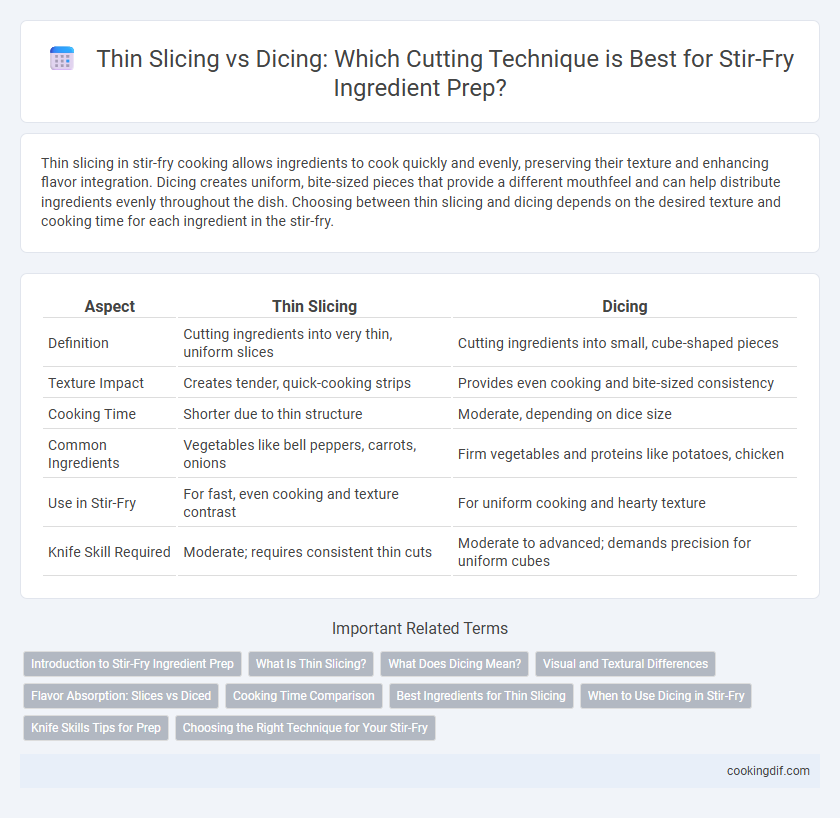Thin slicing in stir-fry cooking allows ingredients to cook quickly and evenly, preserving their texture and enhancing flavor integration. Dicing creates uniform, bite-sized pieces that provide a different mouthfeel and can help distribute ingredients evenly throughout the dish. Choosing between thin slicing and dicing depends on the desired texture and cooking time for each ingredient in the stir-fry.
Table of Comparison
| Aspect | Thin Slicing | Dicing |
|---|---|---|
| Definition | Cutting ingredients into very thin, uniform slices | Cutting ingredients into small, cube-shaped pieces |
| Texture Impact | Creates tender, quick-cooking strips | Provides even cooking and bite-sized consistency |
| Cooking Time | Shorter due to thin structure | Moderate, depending on dice size |
| Common Ingredients | Vegetables like bell peppers, carrots, onions | Firm vegetables and proteins like potatoes, chicken |
| Use in Stir-Fry | For fast, even cooking and texture contrast | For uniform cooking and hearty texture |
| Knife Skill Required | Moderate; requires consistent thin cuts | Moderate to advanced; demands precision for uniform cubes |
Introduction to Stir-Fry Ingredient Prep
Thin slicing ensures fast, even cooking and maximizes surface area for better sauce absorption in stir-fry dishes. Dicing creates uniform, bite-sized pieces that offer consistent texture and quick cooking, ideal for mixed vegetable medleys. Selecting the right cut depends on the ingredient type and desired dish texture, enhancing overall stir-fry flavor and presentation.
What Is Thin Slicing?
Thin slicing in stir-fry preparation involves cutting ingredients into uniform, narrow pieces typically less than 1/8 inch thick, maximizing surface area for quick, even cooking at high heat. This technique ensures vegetables and proteins cook rapidly while retaining texture and flavor, essential for the fast-paced stir-fry method. Compared to dicing, thin slicing enhances caramelization and moisture retention, resulting in a more vibrant and evenly cooked dish.
What Does Dicing Mean?
Dicing means cutting ingredients into small, uniform cubes, typically ranging from 1/8 inch to 1/2 inch in size, which ensures even cooking and consistent texture in stir-fry dishes. This technique helps distribute flavors evenly and allows ingredients to cook quickly and uniformly over high heat. Thin slicing, by contrast, produces long, narrow pieces ideal for quicker cooking but less uniform bite size compared to dicing.
Visual and Textural Differences
Thin slicing in stir-fry preparation creates delicate, uniform pieces that cook quickly and present a smooth, elegant texture, enhancing the dish's visual appeal with slender, translucent strips. Dicing produces small, cube-shaped pieces that offer a chunkier texture and more pronounced bite, contributing to a heartier mouthfeel and a varied visual contrast in the stir-fry. Choosing between thin slicing and dicing impacts cooking time, flavor absorption, and the overall sensory experience of the dish.
Flavor Absorption: Slices vs Diced
Thin slicing ingredients in stir-fry allows for faster cooking and better flavor absorption as the increased surface area is exposed to sauces and marinades. Diced pieces, while smaller, create a more uniform texture and offer consistent cooking but may absorb flavors less intensely due to reduced surface contact. Choosing between slicing and dicing impacts the balance of texture and flavor infusion in stir-fry dishes.
Cooking Time Comparison
Thin slicing ingredients in stir-fry reduces cooking time significantly, allowing for quick and even heat distribution. Dicing increases surface area but requires longer cooking to soften each cube uniformly. For efficient stir-fry meals, thin slicing is preferred to achieve tender-crisp texture faster.
Best Ingredients for Thin Slicing
Thin slicing enhances quick and even cooking in stir-fry recipes, ideal for tender proteins like beef, chicken, and firm vegetables such as bell peppers and carrots. This technique preserves texture and flavor while allowing ingredients to absorb sauces efficiently. Choosing fresh, firm ingredients ensures consistent thin slices that cook uniformly at high heat.
When to Use Dicing in Stir-Fry
Dicing is ideal for stir-fry when ingredients need even cooking and a balanced texture, especially with denser vegetables like carrots or potatoes. Uniform dice sizes ensure rapid heat penetration and consistent doneness, preventing uneven softening or burning. Use dicing for ingredients that benefit from a bite-sized, tender interior while maintaining structural integrity in quick-cook methods.
Knife Skills Tips for Prep
Thin slicing and dicing are essential knife skills for stir-fry preparation, impacting cooking speed and texture. Thin slicing creates uniform, delicate pieces that cook quickly and evenly, ideal for vegetables like bell peppers and mushrooms, while dicing delivers small, consistent cubes suited for firmer ingredients such as carrots and tofu. Mastering techniques like maintaining a sharp chef's knife, using a claw grip for safety, and practicing controlled slicing motions enhances precision and efficiency in stir-fry ingredient prep.
Choosing the Right Technique for Your Stir-Fry
Thin slicing vegetables and proteins ensures quick, even cooking and maintains a tender texture essential for stir-fry dishes. Dicing works best for ingredients that require more surface area for caramelization or a firmer bite, such as potatoes or denser root vegetables. Selecting the appropriate cut depends on the ingredient's cooking time and desired texture, optimizing flavor and consistency in every stir-fry.
Thin slicing vs Dicing for ingredient prep Infographic

 cookingdif.com
cookingdif.com